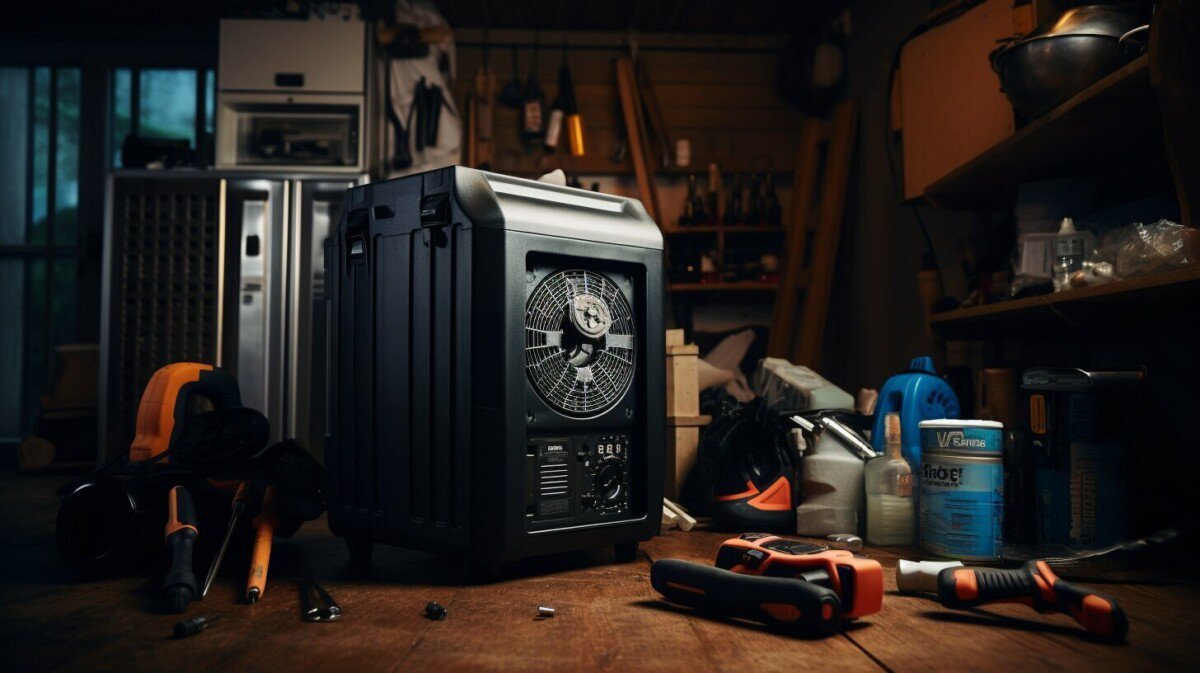If you’re a homeowner, you know how important it is to keep your indoor environment healthy and comfortable. One of the appliances that can help you achieve this goal is a dehumidifier. It can remove excess moisture from the air and prevent mold growth, musty odors, and other issues associated with high humidity levels.
However, like any appliance, a dehumidifier can encounter issues that can affect its performance and efficiency. Troubleshooting your dehumidifier is essential to ensure that it operates smoothly and effectively, especially during the hot and humid summer months.
Understanding How Your Dehumidifier Works
A dehumidifier is an essential appliance for removing excess moisture from the air present in your space. It works by drawing in damp air and removing moisture from it before circulating it back into the room. The water is then collected in a built-in tank for easy disposal.
Dehumidifiers have several components that work together to function efficiently. One of the main components is the compressor, which compresses the refrigerant and pumps it into the condenser. The condenser then cools the compressed refrigerant, which causes the moisture in the air to condense and collect in the dehumidifier’s reservoir tank.
The fan in the dehumidifier draws in the damp air, which passes through the condenser, and the now dry air is circulated back into the room. To enhance the efficiency of the operation, most dehumidifiers are equipped with a humidistat, which regulates the moisture levels in the room.
Dehumidifier Working Mechanism
| Component | Function |
|---|---|
| Compressor | Compresses the refrigerant and pumps it into the condenser |
| Condenser | Cools the compressed refrigerant which causes the moisture in the air to condense and collect in the dehumidifier’s reservoir tank |
| Fan | Draws in damp air, which is cooled in the condenser and then circulated back into the room as dry air |
| Humidistat | Regulates the moisture levels in the room for optimal performance |
It’s important to understand how your dehumidifier works, so that you can keep it running efficiently and troubleshoot any issues that may arise. Knowing the basic components and functions can also help you identify and fix problems if your unit experiences difficulties.
Common Dehumidifier Problems
Dehumidifiers can encounter various issues that can affect their performance. In this section, we will cover some of the most common problems encountered with dehumidifiers and how to troubleshoot them effectively.
Dehumidifier not removing moisture from the air
If your dehumidifier is not removing moisture from the air, it can be due to a dirty or clogged air filter. The air filter might be clogged with dust and debris, which can prevent the unit from functioning correctly. Clean or replace the air filter if it is dirty or clogged to ensure the proper air flow.
The problem can also be due to a malfunctioning compressor or humidistat. Test the humidistat to ensure it is functioning correctly by adjusting the humidity settings. If the compressor is not running, check if the unit is getting enough power and that the thermostat is set correctly.
Strange noises coming from the unit
If your dehumidifier is producing strange noises, it can be due to various reasons, including a loose motor or fan blade, a dirty fan, or a defective compressor. Inspect the motor and fan blades for signs of looseness, and tighten any loose screws or bolts. Clean or replace the fan blades if they are dirty or damaged. If the compressor is defective, you may need to replace it altogether.
Dehumidifier not turning on
If your dehumidifier is not turning on, it can be due to a blown fuse or a tripped circuit breaker. Check the fuse and reset the circuit breaker if they are the underlying issue. If the unit still fails to turn on, inspect the power cord for any signs of damage, and replace it if necessary.
Dehumidifier coil freezing up
If the coil in your dehumidifier freezes up, it can be due to various factors, including a dirty or clogged air filter, low refrigerant levels, or malfunctioning fan. Clean or replace the air filter if it’s dirty and ensure the fan is working correctly. Check the refrigerant level and refill it if necessary or hire a professional to fix the issue.
By understanding and addressing these common issues, you can keep your dehumidifier functioning smoothly and ensure that excess moisture is removed from your home effectively.
Troubleshooting Dehumidifier Error Codes
If your dehumidifier is displaying an error code, don’t panic. Many error codes can be resolved with some basic troubleshooting. Here are some common error codes and how to fix them:
| Error Code | Cause | Solution |
|---|---|---|
| E1 | Temperature sensor failure | Contact customer support or a professional technician to replace the sensor. |
| E2 | Humidity sensor failure | Contact customer support or a professional technician to replace the sensor. |
| E3 | Drainage system failure | Make sure the drain hose is properly connected and not clogged. Clear any obstructions and ensure the drainage system is working correctly. |
| E4 | Water tank full | Check the water tank and empty it if it’s full. Make sure the tank is properly seated in the dehumidifier before restarting the unit. |
If the error code persists after attempting these solutions, refer to the user manual or contact customer support for further assistance. It’s important to address error codes promptly to prevent further damage to your dehumidifier.
Fixing a Dehumidifier That Won’t Turn On
If your dehumidifier won’t turn on, there are a few things you can check to troubleshoot the issue:
- Make sure the unit is properly plugged into a working outlet. Try plugging another device into the same outlet to ensure it’s working.
- Check the circuit breaker to make sure it hasn’t tripped. If it has, reset it and try turning the dehumidifier on again.
- Inspect the power cord for any damage. If there are visible signs of wear, replace the cord or have it repaired by a professional.
- Examine the control board for any visible damage. If the board appears to be damaged, have it replaced by a professional.
- Inspect the thermostat to make sure it’s properly set to the desired humidity level.
- Check the humidistat to make sure it’s operating properly. If it’s not, replace it.
If none of these troubleshooting steps work, it’s possible that the motor is not running. In this case, you may need to have it repaired or replaced by a professional.
Fixing a Dehumidifier That Won’t Collect Water
If your dehumidifier is not collecting water, there may be a few possible causes. Fortunately, most of them are easy to identify and fix.
Check the Filter
The filter in your dehumidifier may become clogged with dust and debris, which can prevent it from collecting water. To fix this issue, remove the filter and clean it with a vacuum or by washing it in warm, soapy water. Once the filter is clean, replace it and restart the dehumidifier to see if the problem is resolved.
Check the Settings
Ensure that the dehumidifier is set to the correct humidity level. If the humidity level is set too high, the unit may not collect any water. Refer to the manufacturer’s instructions to learn how to adjust the settings on your specific model.
Check the Drain Pipe
The drain pipe in your dehumidifier may be clogged or disconnected. Check the pipe for any obstructions or damage, and clean or replace it if necessary. Ensure that the pipe is securely attached to the unit and that it is positioned correctly to allow proper drainage.
By following these troubleshooting tips, you can easily fix a dehumidifier that won’t collect water and ensure that your unit is functioning correctly.
Troubleshooting a Noisy Dehumidifier
A noisy dehumidifier can be a nuisance, especially if you’re using it in a room where you’re trying to sleep or concentrate. Fortunately, troubleshooting a noisy dehumidifier is often straightforward and can help you get back to enjoying the benefits of a quieter home.
Common Causes of a Noisy Dehumidifier
There are several common causes of a noisy dehumidifier that you should be aware of:
| Cause | Solution |
|---|---|
| Loose fan blade | If the fan blade is loose, tighten the screws to secure it in place |
| Worn bearings | If the bearings are worn, replace them |
| Dirty fan blade or motor | Clean the fan blade or motor to remove any buildup that could be causing the noise |
If none of these solutions work, it may be time to replace your dehumidifier with a newer, quieter model.
Steps to Troubleshoot a Noisy Dehumidifier
- Turn off the dehumidifier and unplug it from the power source.
- Remove the front grille from the unit to access the fan and motor.
- Inspect the fan blade and motor for any signs of damage or buildup that could be causing the noise.
- If you notice any buildup on the fan blade or motor, clean it using a soft cloth and a solution of water and mild detergent.
- If the fan blade is loose, tighten the screws to secure it in place.
- If the bearings are worn, replace them.
- Reassemble the unit and test it to see if the noise has been eliminated.
If the noise persists, it may be time to replace your dehumidifier with a newer, quieter model.
Troubleshooting a Frozen Dehumidifier
If your dehumidifier is not functioning correctly, one of the issues you may encounter is a frozen unit. A frozen dehumidifier not only affects the functioning of the device but can also cause it to stop working altogether if not addressed properly.
The cause for a frozen dehumidifier can be due to a malfunctioning thermostat, low refrigerant levels, or blocked air filters. When the refrigerant level is low, the evaporator coil could get too cold, and this would cause the coils to freeze. Blocked air filters will prevent airflow, and this could cause the coils to freeze.
If you believe your dehumidifier is frozen, it is essential to thaw it out as soon as possible. This can be done by turning off the unit and allowing it to defrost for a few hours. If the unit continues to freeze, you will need to take the troubleshooting steps listed below:
| Steps to troubleshoot a frozen dehumidifier |
|---|
| Step 1: Turn off your dehumidifier and unplug it from the power outlet. |
| Step 2: Locate the air filter and remove it from the unit. |
| Step 3: Clean the air filter. Use a soft brush or a vacuum cleaner to clear off any debris or dirt that may have accumulated on it. |
| Step 4: Check the thermostat on the unit to ensure it is functioning correctly. |
| Step 5: Check the refrigerant level on the unit. If the refrigerant level is low, it is best to call a professional to refill it. |
| Step 6: Reassemble the dehumidifier and turn it back on. |
By taking these steps, you can troubleshoot and fix your frozen dehumidifier. If the problem persists, it is best to seek the help of a professional.
How to Repair a Dehumidifier
If your dehumidifier is not working correctly, it may be necessary to repair it to get it functioning properly again. Here are some basic steps you can take to diagnose and fix the issue:
- Identify the problem: Start by identifying the issue with your dehumidifier. Is it not turning on at all? Is it not collecting water? Is it producing strange noises?
- Check the power source: Make sure your dehumidifier is properly plugged in and receiving power. Test the outlet with a different appliance to ensure it’s functioning correctly.
- Examine the filter: A dirty filter can cause your dehumidifier to stop working or not work as efficiently as it should. Remove the filter from your unit and clean it thoroughly with soap and water.
- Inspect the drain hose: Make sure the drain hose on your dehumidifier is free of blockages and is properly connected. If it’s clogged, use a pipe cleaner to remove any debris.
- Check the refrigerant level: If your dehumidifier is not producing cold air, it may be low on refrigerant. Contact a professional to have the refrigerant levels checked and recharged if necessary.
- Examine the compressor: The compressor in your dehumidifier is responsible for compressing the refrigerant and circulating it through the unit. If it’s not functioning properly, your dehumidifier will not work. If you suspect an issue with the compressor, contact a professional for repair or replacement.
Remember to always unplug your dehumidifier before attempting any repairs or maintenance. If you’re unsure about the issue or don’t feel comfortable repairing it yourself, contact a professional for assistance.
Troubleshooting Tips for Dehumidifiers
Now that you understand how your dehumidifier works and common issues that can arise, here are some troubleshooting tips to keep your device in good working condition:
- Regular maintenance: Keep your dehumidifier clean by regularly cleaning or replacing the air filter. Dirt and dust buildup can cause your device to work harder and may lead to malfunction. It is recommended to clean the filter once a month.
- Proper placement: Place your dehumidifier in a well-ventilated area to avoid overheating and to ensure optimal performance. Keep it away from walls and furniture to allow for proper airflow.
- Check the drainage system: Regularly check that the drain pan and hose are not blocked or damaged. You can test the drainage system by pouring a small amount of water into the tank and checking if it flows through the hose or is redirected to the tank properly.
- Inspect the power source: Make sure your dehumidifier is connected properly to the power source. Check if the outlet is working properly by plugging in another device to confirm.
- Regular usage: Regularly use your dehumidifier to prevent moisture buildup, which can cause mildew, mold, and damage to your home. Run it at least once every few days, especially in high-humidity areas and during summer seasons.
By following these tips, you can prevent common issues and keep your dehumidifier working smoothly for longer periods. If you encounter any issues despite taking these precautions, refer back to the previous sections of this guide or consult a professional for assistance.
Troubleshooting Dehumidifier FAQs
Here are some commonly asked questions about troubleshooting dehumidifiers:
Q: Why is my dehumidifier not collecting water?
A: There are a few reasons why this could be happening. First, check to ensure that the unit is set to the correct humidity level and that it is operating in a space with high humidity. If these are not the issues, check to make sure that the air filter is clean and free of debris. Additionally, make sure that the unit’s drain pipe is not clogged and is properly connected.
Q: Why is my dehumidifier noisy?
A: A noisy dehumidifier can be caused by a few different issues. First, make sure that the unit is sitting on a level surface and that all screws and bolts are tightened. If this doesn’t fix the problem, the issue could be with the fan blade or motor. In this case, it’s best to contact a professional for repairs or to replace the unit.
Q: Why is my dehumidifier freezing up?
A: A dehumidifier can freeze up if the space it is operating in is too cold, or if the unit’s refrigerant levels are low. To fix the issue, try raising the temperature in the room or adjusting the unit’s settings. If this doesn’t work, contact a professional to check the refrigerant levels.
Q: Can I repair my own dehumidifier?
A: While it is possible to repair some issues with a dehumidifier, it’s often best to contact a professional for repairs. Attempting to repair the unit yourself can be dangerous and may cause further damage.
Q: How often should I clean my dehumidifier?
A: It’s a good idea to clean your dehumidifier at least once a month, or more frequently if you are using it in a particularly humid space. Cleaning the filter and drain pipe regularly can help ensure that the unit is operating efficiently and prevent issues from arising.
Q: What should I do if an error code appears on my dehumidifier?
A: If you see an error code on your dehumidifier, consult the user manual to determine what the code means and how to troubleshoot the issue. In some cases, this may involve resetting the unit or contacting a professional for repairs.



